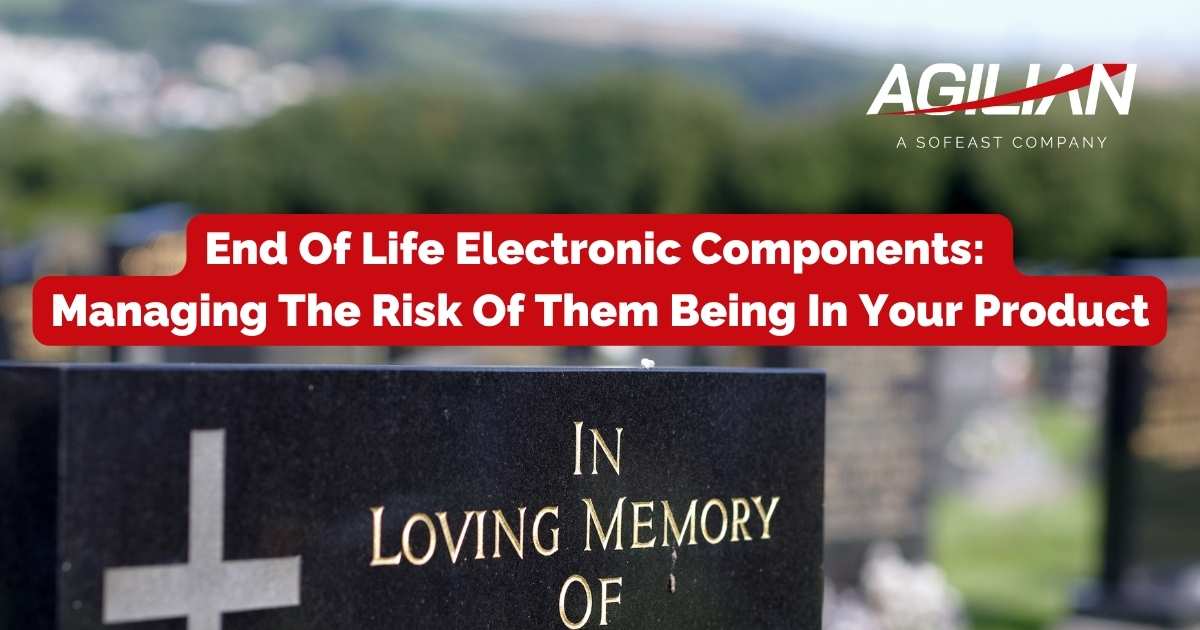
Let’s focus on end of life electronic components.
If you’re manufacturing an electronic product, it may be made up of a myriad of parts from different suppliers. Typically, a battery, a display, a microprocessor or microcontroller, a camera module, etc. But what happens if your supplier starts the process to stop producing one of them, which will get to its ‘end of life’?
In the worst case, you would need to source new parts and redesign the product, going through the entire development and testing process at great expense in time and money if a new part had to be swapped in.
Why does a part go ‘End of Life?’
We assume that you plan for your product to have a lifetime of several years at least. But how about the components in your BOM? What if a supplier stops making one of the components? Could parts going EOL (End of Life) prevent you suddenly from making any more of your product?
Your part supplier may decide to stop making a part that is an important item in your BOM for numerous reasons.
- Maybe the demand has become low so they’re concentrating on different lines.
- The part has become too expensive to produce due to high material or resource costs.
- New technology means that it’s obsolete and has been redesigned to be more efficient and effective.
- Regulations have come into place that make the part non-compliant, this might especially be the case with energy efficiency or similar topics.
Either way, unless your orders make up a significant percentage of their business, they might decide to stop producing regardless of your needs.
Why are end of life electronic components more likely to crop up in supply chains now?
The pandemic, Russian invasion of Ukraine, and rising energy costs, to name but a few reasons, mean that some components have far longer lead times than before even today, especially for passive components and semiconductors. This uncertain business environment also means that older parts could be EOL sooner because suppliers want to concentrate on those that pull in the strongest sales.
Jabil isn’t very optimistic about the future for parts for what they call ‘legacy products’ or those that have been on sale for some time:
As technology keeps developing, there is plenty of demand for more passive components and semiconductors. At the same time, suppliers will likely focus on newer types of parts that are in higher demand. This leaves a high-risk environment for mature, less-profitable product families. Suppliers that continue to manufacture components for legacy products will only produce parts at profitable levels, leading to price increases for the wider customer base.
Investigate which parts are at risk of going EOL
Take a look at your components, then assess which could be at risk of becoming EOL.
- Do you have single-source parts? If so, these are a potential risk as they will be difficult to replace if the supplier stops producing them.
- Do you have some parts that you know are rather old or that only ever get ordered in small quantities? These are also candidates for EOL.
- Have you designed your product around a certain module, for example, a camera or a display? If you have to change to a new model, it might force you to go into months of re-design.
If you consider your estimated production volumes in the future against the above points you should be able to determine which parts, if any, you need to purchase in larger volumes now so you can keep some in stock to avoid future disruption (this can also help if the cost of certain parts is shooting up).
What can you do to reduce your risks of using end-of-life electronic components?
There are several actions you can take to reduce the risks of EoL components derailing the production of your electronic device:
- During your sourcing journey, find backup component suppliers so you have a selection of second-source parts to turn to, especially for critical parts, and you do not rely on single-sourced parts. That’s not always realistic, but it can help a lot.
- Where applicable, select components that you know have suitable off-the-shelf replacements that can be used if need be, for example, branded parts that are usually very similar if and when they’re updated.
- See if your critical suppliers are launching new or alternative products soon.
- Evolve your product design regularly so you use up-to-date parts… if your target market is large enough, a new version should probably come out every 1-3 years.
- Work on building a great relationship with suppliers, especially if the components they produce are critical. It almost goes without saying that if you have a strong relationship, they’re far less likely to spring unpleasant surprises on you or ignore your requests to maintain production of the component you need. Obviously, if they are very large compared to your order size, this is not realistic.
- Monitor the suppliers in your BOM regularly so you don’t miss EOL alerts and other changes that might affect your supply.
If you do work with a contract manufacturer, like us here at Agilian, let us know about your concern and we will review your BOM to make sure that parts aren’t going to be EOL without warning.
Managing your components in the Bill Of Materials
The many components you’re purchasing, the suppliers they’re from, second-source options, and changes to components used will all be updated and stored in your BOM which is a living document.
If you go through the tips above to source a variety of parts to reduce risks of using end-of-life electronic components if a supplier stops production and monitor your supply chain for risks and changes, you’ll need to fill in a BOM, so here’s a walkthrough that can help you do so:



